Lineweights Plot Thicker or Lighter than Expected in AutoCAD
Issue:
When plotting to PDF, printing to a physical printer, or publishing from AutoCAD, object lineweights display thicker, thinner, darker, or lighter than displayed in the drawing.
Causes:
There are several causes for this behavior, including:
- Plot lineweights is enabled.
- Scale lineweights is enabled.
- Lineweights in the drawing are set to a thick width.
- A lineweight override is set for specific objects.
- Drawing is set to plot by color.
- Quality of the PDF being plotted.
- Lineweights or transparency settings in the plot style table (CTB or STB).
- The default setting for lines is not set to 0.
Solution:
Try one or more of the following to resolve this issue:
Lineweight display looks different in AutoCAD from the printout or plot
This might be due to the lineweight display being deactivated:
- Type LWDISPLAY in the AutoCAD command line to toggle the lineweight display.
- Type ON to switch the variable on.
Turn off lineweight options in plot or page setup
In the Plot or Page Setup dialogue window, turn off the following two settings:
- Plot object lineweights.
- Scale lineweights.
On Windows:

On macOS:
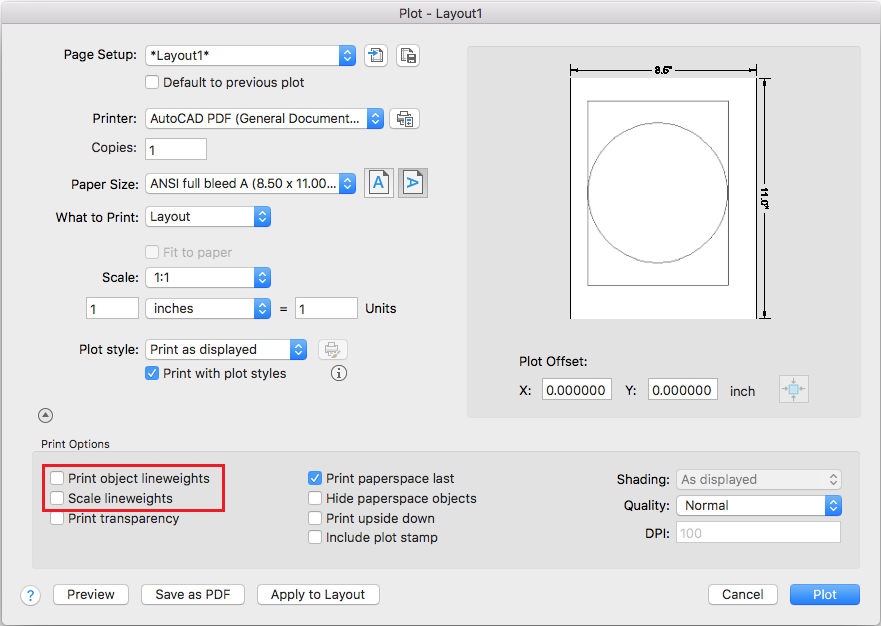

It's a good idea to save the page setup when you are done and apply it to all the layouts in your template so when you publish your jobs the settings will be applied automatically on all pages.
Change lineweight to the desired thickness
- On the ribbon in AutoCAD, click the Home tab > Layers Panel > Layer Properties.
- In the Layer Properties Manager, under the Lineweight column, click the lineweight to change.
- In the Lineweight dialog window, choose the lineweight to use as the default for objects on that layer.
Set the object lineweight to be controlled by the layer
- Select the objects.
- Type PROPERTIES in the command line and press Enter.
- Under the Lineweight drop-down, select ByLayer.

Note: Blocks and Xrefs will need to be opened to change the lineweight for objects within them.
Check that the layer is using the correct lineweight
- Select the objects.
- Type PROPERTIES in the command line and press Enter.
- Under the Lineweight drop-down, verify that it is set to ByLayer.
- Enter LAYER .
- In the Layer Manager, go to the relevant layer.
- Set the desired lineweight there.
Set the drawing so that object lineweight is controlled by the layer
- With no objects selected, type PROPERTIES and press Enter.
- Under the Lineweight drop-down, select ByLayer.
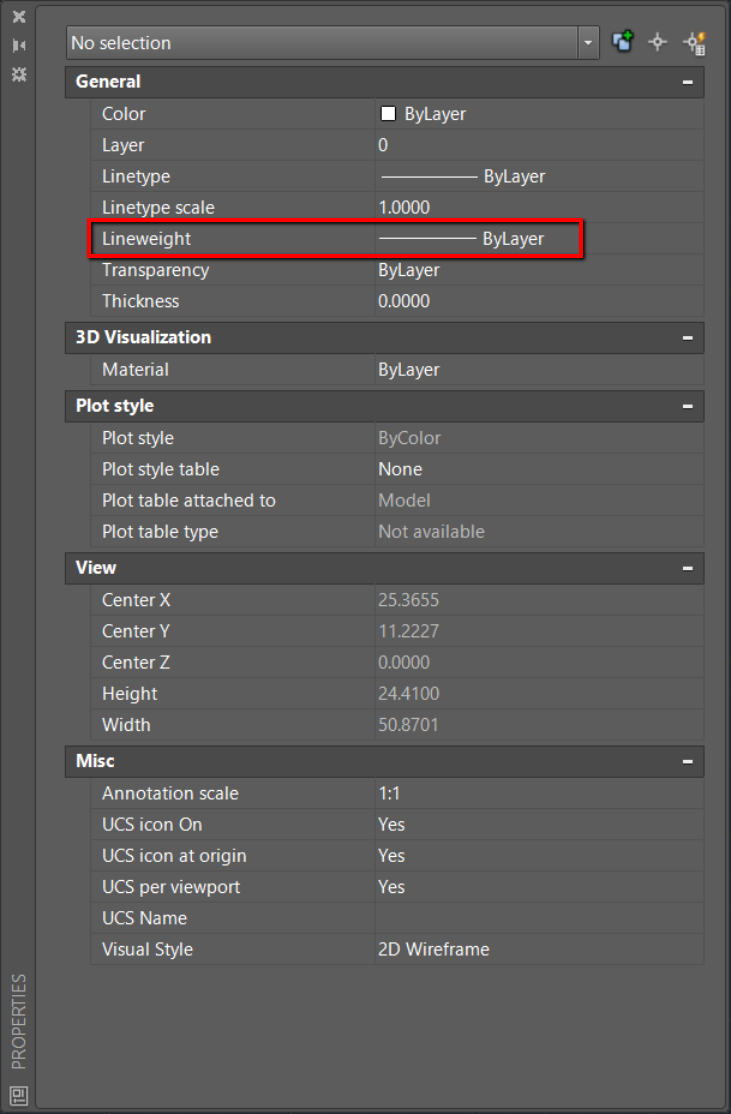
Change the lineweight for dimension lines
- Check which dimstyle is used for the dimension which has thick lines.
- Enter DIMSTYLE in the AutoCAD command line.
- Select the corresponding dimstyle.
- Change the lineweight to a thinner style.
- Press OK.
- Some dimensions might need to be created new.
Select a PDF plotter or settings with higher plot quality
Plot using the AutoCAD PDF (High Quality) plotter or adjust the setting of the selected driver for the highest quality plot.
Lineweights or transparency in the plot style table
Set the plotted lineweight and transparency in the desired plot style table (see To Set the Plotted Lineweights ).
- Type PLOT in the command line.
- Press the button next to the Plot Style Table to edit the CTB file. This example edits the Grayscale.ctb file.
- In the Form View Tab, edit the Lineweight for color 1 as desired. For example: set it to 0.7000 mm.
- Press the Save As option to make a new Plot Style Table.
- Name the new Plot Style Table file. For example, Grayscale_edited.ctb .
- Press Save and Close.
- Press ESC to exit the plot layout window.
- Type PLOT again and change the Plot Style Table to Grayscale_edited.ctb
- Click OK.
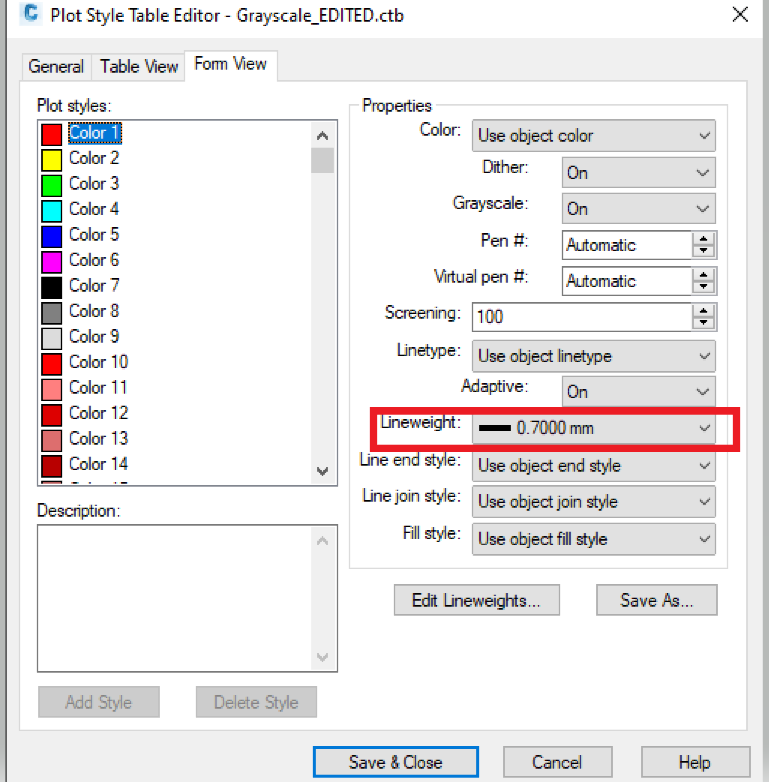
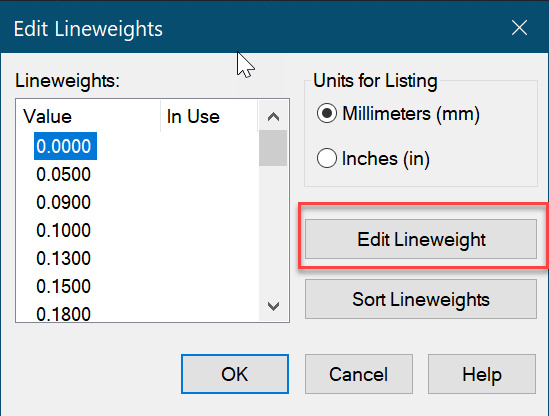
Change line thickness settings in the PDF viewer
Select a PDF plotter or settings with higher plot quality.
Try deactivating or activating both these settings:
- Smooth line art.
- Enhance thin lines.
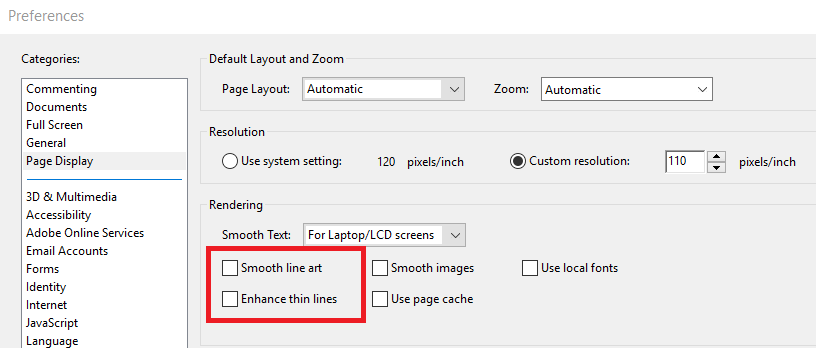
Check the settings of the Default lineweight value for Polylines
- Type LWDEFAULT to command line and Enter.
- Change the value to 0.
Related Articles
AutoCAD Keyboard Commands
Learning how to use AutoCAD keyboard commands can help you work faster and improve your efficiency. This article lists the abbreviated commands that can be used in AutoCAD (Toolbox). Toggle General Features Ctrl+G Toggle Grid Ctrl+E Cycle isometric ...Overview: Sheet Set Manager - AutoCAD
The Sheet List tab displays an ordered list of sheets. You can organize these sheets under headings, called subsets, that you create. List of Options This tab has the following buttons: Publish to DWF Publishes selected sheets or a sheet set to a ...Microvellum Commands vs AutoCAD Commands
Toolbox, as an OEM based on AutoCAD, possesses the full range of AutoCAD commands for use in accessing AutoCAD functions, such as drawing shapes, opening menus, altering the dimensions of polylines, etc. However, it should be noted that when working ...About Sheet Sets in AutoCAD
You can manage multiple drawings as sheet sets with the Sheet Set Manager: A sheet is a selected layout from a drawing file. You can import a layout from any drawing into a sheet set as a numbered sheet. A sheet set is an organized and named ...To Work with Comparing XREFs in AutoCAD
Use various commands and display options in the Xref Compare toolbar to review the differences between the attached xref and the referenced drawing file. Compare the Xref Changes Click View tab > Palettes panel > External References Palette. Find ...
Recent Articles
Toolbox Release Notes | Build 25.1.1218.641
The following release notes apply to Toolbox build 25.1.1218.641 Part Properties Fixes A handful of issues centered around the Part Properties interface have been resolved: The Reference for Measurement tool in the interface has been fully removed ...Transferring Global Variables to a new Library
This article will explain the process of transferring customized Global Variables from your current library to a new installation of the Microvellum Foundation Library. The G! Workbook The Foundation Library contains all standard and custom data in ...Microvellum Foundation Library Release Notes | Build 25.1121
The following release notes apply to the Microvellum Foundation Library build 25.1121. Additions Added the new product, Master Island End Cabinet, to the Master Cabinets FF product category. Added the Nesting Optimization Report Select Processing ...Toolbox Release Notes | Build 25.1.1204.641
The following release notes apply to Toolbox build 25.1.1204.641 Toolbox Login Screen Update Fig. 1: The updated Toolbox Login interface. The Toolbox Login interface has had several changes applied to it to enhance its usability and allow for greater ...Toolbox Release Notes | Build 25.1.1120.641
The following release notes apply to Toolbox build 25.1.1120.641 Mouse Wheel Fix There was a reported issue in certain interfaces (such as report groups) in which hovering over a dropdown menu (such as Output Type) would result in the options within ...